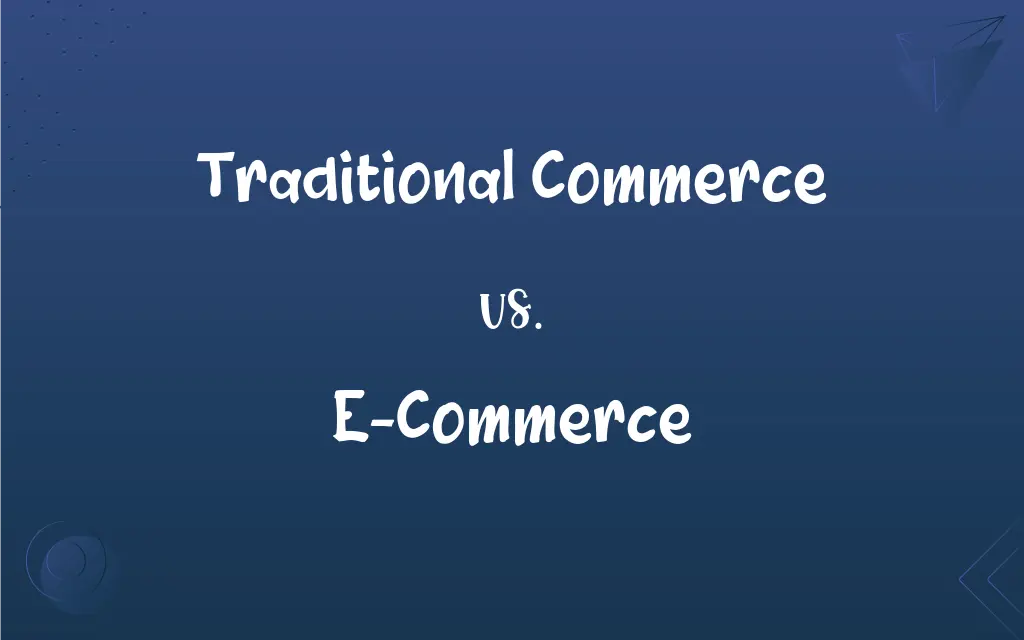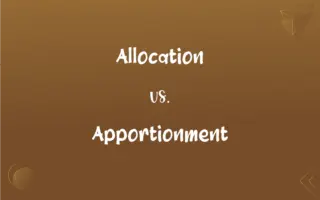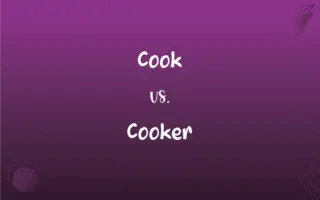Traditional Commerce vs. E-Commerce: What's the Difference?
By Janet White || Published on December 2, 2023
Traditional commerce involves buying and selling goods or services in physical stores. E-commerce refers to buying and selling online, using digital platforms.

Key Differences
Traditional commerce is characterized by physical transactions where buyers and sellers interact in a brick-and-mortar setting. It includes all aspects of business, like retail, services, and wholesale, conducted in physical locations. E-commerce, on the other hand, operates in a virtual environment where transactions are conducted over the internet, often through websites or mobile apps, without the need for physical stores.
In traditional commerce, the customer experience is tangible, with face-to-face interactions, allowing customers to physically examine products. Physical stores also offer immediate product ownership after purchase. E-commerce offers a digital customer experience where interactions are virtual, and products are viewed and selected online, with a wait time for delivery.
Traditional commerce relies on physical advertising methods like billboards, print media, and word-of-mouth. It requires significant investment in physical infrastructure, such as store premises and inventory management. E-commerce leverages digital marketing tools like SEO, social media, and online advertising. It can operate with smaller physical footprints and often uses drop-shipping or direct manufacturer delivery.
Traditional commerce usually operates during specific hours and is limited by geographical boundaries. It offers a personal touch and customer service in a physical setting. E-commerce is accessible 24/7 from anywhere with internet access, offering convenience and a broader reach, but with less personal interaction.
Payment methods in traditional commerce often include cash, credit cards, and checks, and transactions happen in-person. In E-commerce, transactions are electronic, using credit/debit cards, digital wallets, or online payment systems, enhancing transaction speed and convenience.
ADVERTISEMENT
Comparison Chart
Transaction Setting
Physical stores or locations.
Online platforms and websites.
Customer Interaction
Face-to-face, personal interaction.
Virtual, often automated interactions.
Accessibility
Limited by store hours and location.
Accessible anytime, anywhere with internet.
Marketing Strategies
Physical advertising, in-store promotions.
Digital marketing, online advertising.
Payment Methods
Cash, cards, checks, in-person.
Electronic payments, digital wallets, online transactions.
ADVERTISEMENT
Traditional Commerce and E-Commerce Definitions
Traditional Commerce
The conducting of business transactions in physical locations like stores or offices.
She purchased a dress from a boutique, a typical traditional commerce experience.
E-Commerce
Conducting commercial transactions electronically on the internet.
Small businesses often use e-commerce platforms to reach a wider audience.
Traditional Commerce
Business transactions that occur in a tangible, real-world environment.
Traditional commerce thrives in shopping malls where customers can browse multiple stores.
E-Commerce
The buying and selling of goods and services over the internet.
He bought his new laptop through an e-commerce website.
Traditional Commerce
Exchange of goods and services in a face-to-face setting.
Attending trade shows is an important aspect of traditional commerce for many businesses.
E-Commerce
Online shopping and business, using websites and digital platforms.
Black Friday has become a major event for e-commerce retailers.
Traditional Commerce
Buying and selling using physical interactions and brick-and-mortar stores.
The local grocery store is a prime example of traditional commerce in action.
E-Commerce
Business model that enables online sales, often through virtual storefronts.
Social media has become an integral part of e-commerce marketing strategies.
Traditional Commerce
Commercial activities conducted in physical marketplaces.
Farmers' markets are a form of traditional commerce, connecting producers and consumers.
E-Commerce
Internet-based trade, involving digital transactions and online payment.
The rise of e-commerce has made international shopping more accessible.
E-Commerce
Commerce that is transacted electronically, as over the internet.
E-Commerce
Commercial activity conducted via the Internet.
E-Commerce
2005|year=2006|publisher=Apress|page=xxi|pageurl=https://books.google.com/books?id=4ShE_7yml28C&pg=PR21&dq=%22e-commerce%22+web&hl=&cd=20&source=gbs_api#v=onepage&q=%22e-commerce%22%20web&f=false|isbn=978-1-4302-0079-6|passage=The last thing you need to do before launching the e-commerce site is enable credit card processing.}}
FAQs
What is traditional commerce?
Traditional commerce refers to buying and selling goods or services in physical locations like stores.
What are the advantages of traditional commerce?
Traditional commerce offers personal customer service, immediate product ownership, and a tangible shopping experience.
What is e-commerce?
E-commerce involves conducting business transactions online, through websites or mobile apps.
Can a business combine traditional commerce and e-commerce?
Yes, many businesses operate both physical stores and online platforms to maximize reach.
How do marketing strategies differ between traditional and e-commerce?
Traditional commerce relies on physical advertising, while e-commerce uses digital marketing techniques.
How does customer interaction differ in traditional commerce and e-commerce?
Traditional commerce involves face-to-face interaction, while e-commerce is primarily virtual.
Can e-commerce reach more customers than traditional commerce?
Yes, e-commerce has a global reach, allowing businesses to access a wider customer base.
How do payment methods differ in traditional commerce and e-commerce?
Traditional commerce includes cash and in-person card payments, while e-commerce primarily uses electronic transactions.
Is e-commerce more cost-effective than traditional commerce?
E-commerce can be more cost-effective due to lower physical infrastructure needs.
How do customer trust levels compare between traditional commerce and e-commerce?
Trust levels can vary, with traditional commerce often perceived as more trustworthy due to physical interactions.
What are the benefits of e-commerce?
E-commerce offers convenience, broader reach, 24/7 availability, and often wider product selections.
Is traditional commerce limited by geographical boundaries?
Yes, traditional commerce is often limited to specific geographical locations.
Does e-commerce operate round the clock?
E-commerce platforms are generally accessible 24/7, unlike physical stores with specific operating hours.
Can e-commerce provide personalized customer experiences?
Yes, e-commerce can offer personalized experiences through data analysis and targeted marketing.
How has e-commerce affected traditional retail?
E-commerce has introduced competition for traditional retail, leading to changes in consumer behavior and business models.
How does product delivery work in e-commerce?
In e-commerce, products are ordered online and delivered through shipping services.
Do traditional commerce and e-commerce use different inventory management systems?
Yes, they often use different systems, with e-commerce requiring more dynamic inventory management.
Are returns and exchanges different in e-commerce compared to traditional commerce?
Returns and exchanges in e-commerce typically involve shipping the product back, unlike immediate returns in stores.
Can traditional commerce offer the same variety as e-commerce?
Physical space limitations mean traditional commerce often has less variety compared to e-commerce.
How important is website design in e-commerce?
Website design is crucial in e-commerce for user experience, navigation, and conversion rates.
About Author
Written by
Janet WhiteJanet White has been an esteemed writer and blogger for Difference Wiki. Holding a Master's degree in Science and Medical Journalism from the prestigious Boston University, she has consistently demonstrated her expertise and passion for her field. When she's not immersed in her work, Janet relishes her time exercising, delving into a good book, and cherishing moments with friends and family.






































































